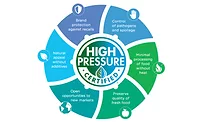Tech | Processing
Post-Packaging pasteurization advances

Processors have several options for pasteurization, including high-pressure pasteurization (HPP), hot water, steam, hot air, infrared heat, radiofrequency and irradiation. Hot water, steam and HPP are the most popular, with HPP and hot water growing the fastest, says Wes Shilling, professor of food science at Mississippi State University in Mississippi State.
“Hot water is the easiest to implement and is very effective if the appropriate time and temperature is used,” Schilling says. “Systems are also available for hot water and steam that are placed in the production line and are able to both heat and cool the product. HPP is growing because it is becoming more available, does not expose the product to heat and some industry leaders have implemented it.”
HPP allows for a lethality procedure on products that would not handle a heat treatment well, such as packages of sliced, cooked meat products. Hot water and steam processes seem to have become less popular for post-packaging pasteurization of meat products. The two processes would be used primarily for larger diameter whole-muscle or chunked and formed products, says Lynn Knipe, extension processed meat specialist and associate professor at Ohio State University, in Columbus.
Rodrigo Tarté — assistant professor in meat science at Iowa State University, in Ames — sees processors more widely using thermal post-package pasteurization and HPP, depending on their process. Growing in use is the technology of cooking products in their final package, in which a product is partially cooked, placed in its final package and then cooked to lethality. This form of thermal post-package pasteurization is growing because it saves processors time and energy over standard pasteurization systems, he explains.
Applegate, a brand that focuses on producing clean-label products, primarily uses HPP for its ready-to-eat, refrigerated foods because they pose the greatest risk for pathogens, says Jim Graham, the brand’s vice president of research and development. “HPP gives us the best tool to preserve the freshness of our deli meat, bacon, hot dogs and dinner sausages without using additives or affecting the taste, texture or nutritional value,” he says.
Understanding process
When considering post-packaging pasteurization options, some ingredients can be sensitive to thermal pasteurization.
“You always have to understand the properties of an ingredient, and what process you are going to put it through,” Tarté says.
Looking for quick answers on food safety topics?
Try Ask FSM, our new smart AI search tool.
Ask FSM →
Processors also must work with packaging suppliers to make sure they are using packaging materials that can withstand HPP, hot water or thermal post-package pasteurization, he adds.
While the number of HPP processors in the industry has grown exponentially, it is still a relatively novel technology, which can make cost an issue. “Using HPP also can present some challenges with including value-adds to packaging like immediate redemption coupons,” Graham adds.
In addition to the cost of HPP equipment, the extra handing involved and the effect of the processes on quality — particularly the quality of sausage products — are still concerns for meat processors, Knipe says. “Many large companies have opted to use co-extrusion processes, which eliminate the need to expose cooked sausage products to the environment, prior to the packaging process,” he says.

While maximizing production times can be challenging when implementing post-package pasteurization because of the added processing time, Shilling thinks use of HPP will increase, and that use of hot water will continue. He also thinks infrared and microwave heating may grow. Still, the greatest advancements are occurring with computers, technology and engineering, he says, along with the ability to place fully automated hot water and/or steam systems within the processing line that have the ability to both heat and cool.
Moving forward, Tarté also thinks more processors will continue to use post-package pasteurization because it’s been validated. “Especially when you think of the clean label trend of the last 10 to 15 years or so, it enables you to not have to rely on antimicrobial ingredients and to eliminate lactates, diacetates and organic acids from the ingredient statements,” he says.
While HPP has many benefits, such as increased shelf life and food safety, other emerging benefits of HPP include tenderization, color stability and replicating the aging process in some raw material. “That being the case, I think there can be other opportunities to use HPP beyond food safety and in the pursuit of developing great-tasting food with clean ingredient statements,” Graham says.
New advancements, including thermal or retort processing, and work being done in antimicrobial films also will benefit the industry as it strives to fulfill the increasing consumer demand for foods with clean ingredients, he adds.









